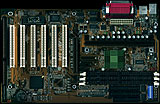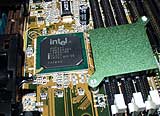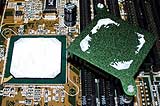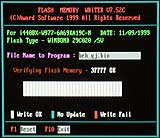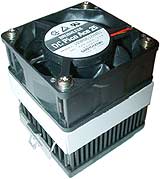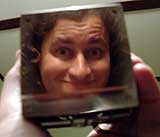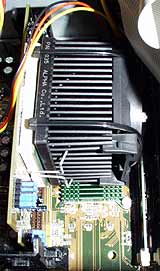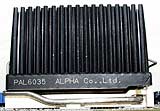
An overclocking adventure
Review date: 7 February 2000.Last modified 03-Dec-2011.
I've got a 700MHz Coppermine P-III.
Well, more accurately, I've got a 500MHz FC-PGA Coppermine P-III, a cheapo Slot 1 adaptor ("slotket") for it, and an Abit BF6 motherboard. The above, plus a small amount of fiddling, let you turn the $AU500-or-so 500E into the equal of an $AU1500-or-so 700E.
When you consider that the BF6 costs less than $AU250, and the slotket about $AU25 (many dealers will throw one in for free with a CPU), this looks like not a bad deal at all. Particularly if you're building a new PC or upgrading an old one that's not P-III ready, so you'd have to buy a new motherboard anyway.
If, at this juncture, you're saying "what the HELL is this guy talking about?", hang in there. I'll explain.
If, however, you're saying "So what? I put a Polar Logic cooler on the SL3Q9 Andy Groves personally delivered to me and got it to 1GHz; would have done better except the stacked Peltiers keep freezing the mineral oil," then you may learn something from this article too. Even if it's only how the other half lives.
The English translation
What we're talking about here is overclocking. Running Central Processing Units (CPUs) faster than their sticker speed. CPUs are engineered to be reliable at their sticker speed, even if they're on a cheapo motherboard in a stifling, underventilated case, with a poorly fitted heatsink and an overloaded, underperforming power supply. Improve some or all of these factors and the CPU can run faster. Sometimes a lot faster.
Whether you can overclock a current model Intel processor depends on your motherboard - the board your computer's built on, into which all of your drives and RAM and cards plug. And, of course, into which the CPU also plugs.
If a motherboard sticks to Intel's specification, it can't be overclocked. On the plus side, Intel spec boards are easier to set up.
This is because all Intel chips, for quite a while now, have had some of their multitude of pins devoted to reporting what they want from the motherboard.
There are some pins that say what the processor's proper Front Side Bus (FSB) speed is, for instance. The FSB setting is the speed in megahertz (millions of cycles per second) at which the processor talks to the motherboard chipset, and at which the motherboard chipset talks to the system RAM.
There are also pins on the CPU that report what multiplier the processor uses - how much faster than the FSB the processor core runs. If the FSB is 66MHz (66 and two thirds, actually - the fractional component is seldom mentioned), and the multiplier is 5X, then the processor speed will be 333MHz.
And there are pins that say what the processor's core voltage is, so the motherboard can feed it the right number of volts. To little voltage, processor doesn't work. Too much voltage, processor overheats and shuts down. Far too much voltage, processor dies.
Drop a processor into an Intel standard motherboard, therefore, and you don't need to tell the computer anything about its new CPU. If the CPU is, say, a regular Pentium III 500E, the motherboard knows that it's a 1.6 volt, 100MHz FSB, 5X multiplier CPU. Presto, correct setup.
(Well, that's the theory, anyway. There's more on these newfangled P-IIIs with Es and Bs after their names in my slotket review.)
Things get interesting when motherboards start taking the settings dictated by the processor more as hopeful suggestions than as commands. And Abit's BF6 is one of the front-runners in this area.
The mechanics of overclocking
All three of the standard processor settings - FSB, multiplier and voltage - can be used to overclock. Various motherboards let you change at least the first two, and often the third as well.
But multiplier twiddling can only be used on quite old processors, because Intel has for some time now been "locking" the multiplier of their CPUs - fixing it so it stays on its factory setting regardless of what the motherboard's set to.
The reason for this is simple enough; if anybody can change the multiplier, anybody can wind the multiplier up on a processor until it's running - maybe stably, maybe not - at exactly the same speed as a much more expensive chip. There was no way, short of opening the computer and looking at the processor, to tell a genuine 333MHz (5X, 66MHz) processor from a 266MHz (4X, 66MHz) one that had been wound up. Which meant that miscreants could sell the resulting maybe-stable overclocked computers as if they had the genuine faster processors, for a handsome profit.
This "remarking" happened a lot before multiplier locking came along. Some shifty dealers even went so far as to machine the text off the surface of processors and print new labelling.
With the multiplier lock, it suddenly became much harder to rip people off by remarking processors. Unfortunately, multiplier locks also inhibit legitimate overclocking by users who have no intention of selling their overclocked mutton as lamb, or even of complaining to Intel if they somehow manage to blow up their processor.
With a locked multiplier, the only way you can change the processor speed is by changing the FSB speed. If the board won't let you do that, or won't run at a faster FSB speed than the one the processor is meant to use, you can't overclock. FSB-overclocked processors are also unlikely to end up running at a "standard" speed, so it's harder for a hapless buyer to be conned into thinking they're the genuine higher-priced article. If some unscrupulous dealer's building machines with cheap 433MHz Celerons (66MHz bus, 6.5X multiplier) and gooses the FSB to 75MHz, he'll be trying to sell 488MHz computers. Which the customers are likely to notice.
Fortunately, nowadays, even basic Taiwanese boards support at least a few FSB speeds. Many support, frankly, TONS of settings. AOpen's AX6BC Pro II (I review the over-the-top Millennium Edition of this board here) supports 15 FSB settings, for instance (although its outrageous higher speeds, going all the way up to 153MHz, aren't really likely to be useful for much). Abit's wildly popular BP6 offers 30 speeds between 66 and 133MHz, and breaks Intel rules completely by allowing you to use twin Celeron processors to build dirt cheap serious rendering or server machines (the Celeron's meant to be a single-processor-only deal).
And the Abit BF6, the latest board to hit my review table, offers a total of 120 FSB speeds.
This isn't quite as impressive as it sounds, because the speeds above 150MHz are, for all practical intents and purposes, useless. To understand why, you have to understand the drawbacks of FSB overclocking.
FSB overclocking pitfalls
When you wind up the bus speed, the processor isn't the only component that gets faster. You tend to overclock everything else in the computer at the same time.
The speeds of all of the other buses in the PC are tied to the FSB, with their own fractional multipliers - they want to run slower than the FSB. The PCI bus, for instance, is supposed to run at 33MHz. The PCI bus is what pretty much all regular expansion cards these days plug into; the BF6 retains one old-style ISA slot, and has one AGP slot for a video card, but everything else is PCI. Importantly, the IDE hard drive controller shares the clock speed of the PCI bus.
The PCI bus has a 1/2 multiplier (or a divisor of 2, depending on your mood) when the FSB is 66MHz, and 1/3 when it's 100MHz, and 1/4 when it's 133MHz. Many recent motherboards support the 1/4 multiplier, but they don't generally let you select it, or any of the others, manually. They just click over to the next setting when they're running at the appropriate FSB speed, or faster.
The PCI bus itself doesn't much care about overclocking - pretty much all motherboards that let you set odd FSB speeds are well enough made that they can keep the signals in a row and function properly. But the cards you've got plugged into the bus may well not like speeds much higher than 33MHz.
If you're asking for only about 10% more, you'll probably have no problems. The simple 66-to-75MHz overclock, for instance, is only 9/8ths of standard speed and can be handled by pretty much any system. If you're asking for 20% or more, though, you may have problems.
These problems are worst with motherboards that don't let you select the PCI multiplier manually. If you've got a lots-of-FSB-settings motherboard running at 99MHz, for instance, and you're still on the 1/2 divisor, your PCI bus is at 49.5MHz. This is 50% over spec, and you can reasonably expect various PCI cards to be unhappy, and quite possibly your hard drives as well. Likewise, if you're at 120MHz and still on 1/3, you're overclocking your PCI bus by the same 20% margin as your FSB.
The simple solution, if you've got a motherboard that lets you, is to pick the next divisor up before you get to that speed. Running at, say, 120MHz with a 1/4 multiplier means you'll "underclock" your PCI bus to 30MHz, which none of your cards will have a problem with. Underclocking makes those devices transfer data to and from the computer slower, but does not generally affect how quickly the card itself does whatever it does. The small performance loss from PCI underclocking can be more than offset by the performance gain from processor overclocking.
One of the BF6's several nice features is that it lets you manually set the PCI bus multiplier. You can use 1/4 FSB speed with any FSB setting at all.
AGP overclocking
There's a worse problem than PCI bus speed. Accelerated Graphics Port (AGP) bus speed.
The Intel i440BX motherboard chipset was introduced along with the first 100MHz FSB processors and is still going surprisingly strong. Most of the top-flight overclocking boards still use the BX chipset, and the BF6 is one of them. But BX supports only two multipliers for AGP speed - 1/1 (AGP speed equal to FSB speed) and 2/3.
AGP is supposed to run at 66MHz. If that's your FSB, you run the AGP bus at 1/1; if you're using 100MHz FSB, you use 2/3. The faster "2X" and "4X" AGP transfer modes achieve their multiplied throughput by sending more bits per clock pulse; both of them still run at 66MHz.
What if you're running at 133MHz FSB, though?
Well, if you're doing it with a BX chipset motherboard, Intel don't want to know. They've got chipsets that have a 1/2 AGP multiplier - the i810E, i820 and i840. They don't want you using their old chipset, they want you buying their new ones. Unfortunately, 810 boards are all low-end all-in-ones that don't even have an AGP slot. And 820 and 840 boards only give full performance if you use outrageously expensive Rambus memory modules. As a result, BX boards are still selling well, as are boards that use Via's Apollo Pro chipset, which uses plain SDRAM but has a 1/2 AGP multiplier.
If you're using a BX board, higher-than-100MHz FSB speeds are no problem. Ingenious engineers at companies like Abit and ASUS and AOpen have made BX motherboards that can run stably at 133MHz and faster. The Abit BF6 is one such. So's the AOpen AX6BC Pro II. But no amount of ingenuity on the engineers' part can fix the lousy two AGP multipliers, so FSBs over 100MHz overclock the AGP bus too.
Some AGP video cards don't like being overclocked. Again, 10% or so is possible with just about anything, but much more may not be.
RAM speed
When you're playing with high FSB speeds, you also need memory that can handle it.
There are three basic speed specification levels for the SDRAM DIMM (Dual Inline Memory Module) RAM that motherboards since the advent of Slot 1 processors have used. Essentially, you need RAM that's rated for the FSB speed you choose, because the RAM is accessed at full FSB speed.
PC66 RAM is rated for 66MHz FSB. It'll probably be OK at 75MHz, and might work at 83MHz as well, but I wouldn't bet on it. PC100 RAM is generally good for any speed up to 110MHz, and better modules may cut it at 120MHz or above. PC133 RAM is what you want for serious overclocking of 100MHz FSB processors; any PC133 module should be OK as fast as the BF6 can run it.
High FSBs on BX motherboards can often require a fiddling with your RAM locations. The BF6, like many BX boards, has three DIMM slots, but the one furthest from the processor can cause problems at high FSB speeds. I used a couple of cheap Kingmax PC133 modules in my test machine (barely more expensive than PC100, because they're only CAS 3), and had a hard time booting until I moved the two modules into the two slots nearer the processor.
For most users, this won't be a problem, because most people only have one or two RAM modules. If you want to fill all three slots, though, think again; you may need to trade a couple of your RAM modules for a single larger capacity one.
In practice!
What all this adds up to is that with a BX board like the BF6, you can use most imposing FSB speeds, but not if you're also using an AGP graphics card. My own experiments bear this out.
Intel Australia kindly furnished me with a P-III 500E, Abit Taiwan set me up with a BF6, and my site sponsors Aus PC Market came through with a couple of Socket 370 to Slot 1 adaptor boards ("slotkets"; I review them separately here). An essential component of any highly overclocked system is a CPU cooler the size of the Empire State Building; one such was supplied by Alpha, acknowledged kings of the serious CPU cooler. Their PAL6035MUC was, actually, a bit too humungous, but I found a way around that, as you'll see.
And, anticipating a need I hadn't even expressed to them, 3dfx sent me a Voodoo 3 2000 PCI video card. Which came in rather handy, as it happened.
Step one was setting up all of the new gear.
The BF6
Abit's BF6 is now their "basic" BX board. But every motherboard they make is a fancy overclock-ready unit, including this one; you don't miss out on any CPU-stretching capabilities by going for the BF6. It sells for about $AU220, versus more than $320 for the BE6-II.
The BF6 is a funny looking motherboard. It's got more componentry than many boards, including a block of DIP switches in one corner, but it's also got some funny blank spots with solder pads on them.
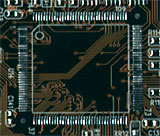
The empty space is there because the BF6 and another Abit motherboard, the BE6-II, share the same circuit board. The BE6-II has one less PCI slot than the BF6 (and a funny blank spot, with solder pads, where the slot would be...), but adds an Ultra DMA/66 hard drive controller, and a couple more IDE connectors to go with it.
The chief difference between the BF6 and the BE6 II is the UDMA-66 controller, which the BE6 has and the BF6 doesn't. With visions of 66 megabyte per second transfer rates dancing in their heads, a lot of users think UDMA-66 is a big deal. It isn't, really. The only time a single hard drive will even get close to saturating UDMA-66 bandwidth is when it's moving data from its cache, not when the actual electromechanical spinning thing's involved. Faster cache transfers do make a difference, but since no two UDMA-66 compatible drives can saturate the one channel of the interface they'll be connected to with their sustained throughput, the difference is not nearly so large as the raw available bandwidth numbers suggest. UDMA-66 hard drives are very common these days and cost little more than UDMA-33 units, so feel free to buy them if you like - but you'll see very little hard drive performance difference if you plug them into the older interface.
Since hard disk performance has, in general operation, only about a 10% influence over the overall performance of a computer (in other words, doubling your hard disk speed will give you about a 10% system speed improvement), the real world difference between Ultra ATA 33 and 66 is negligible. The chief advantage of DMA/66 equipped boards is that you can put up to eight drives on 'em before you have to shell out for another hard disk controller. If you don't need that many drives - and few people do - then trading the DMA/66 controller for another PCI slot seems a good deal to me.
Setting up
Installing the BF6 is easy enough for anyone who's installed a motherboard before, but could be somewhat alarming for the beginner. There's no colourful, cheerful "Getting Started" guide, and the manual's diagrams are adequate but not pretty. This is an old-style motherboard manual, with character quirks like descriptions that don't quite match the board, and a dire, but quite wrong, warning that drive auto-detection won't work with drives that are already formatted.
There's an impressive number of things a newbie can get wrong when installing a motherboard. Connecting drives backwards, plugging case light and switch connectors onto the wrong headers, not pressing the pins that hold the processor retention clips in place hard enough, mis-seating RAM or expansion cards, just plain forgetting to plug things in, and of course frying the whole shebang with static electricity are all exciting possibilities.
You don't need to be a technical whiz to get it right, and there are plenty of handy guides to help you (like my own how-to-build-a-PC piece here, which is from the days when the P-II was king but which is still perfectly relevant to P-III systems). But if you're easily frightened, get the board installed for you.
With Abit's SoftMenu III software CPU setup, of which more in a moment, you can then go on to fiddle with your low-level system settings all you like without ever having to crack the case. There's a CMOS Clear jumper on the motherboard, which resets everything to defaults, but you'll probably never need to use it. If you over-overclock, set your processor voltage way too low, or in some other way create a computer that's forgotten where its brain is, you can hold down the Insert key while booting, or just turn the machine on and off three or four times. This tells the BIOS to reset the CPU to safe, slow, default settings.
You might need to use the CMOS Clear jumper if you managed to tell the computer to boot from nothing but some drive it didn't actually have, or something. It'd take some ingenuity.
The jam-packed layout of the current BE/BF series boards might make them slightly awkward for some users. Like, for instance, me. The space assigned to the Ultra ATA-66 hardware (absent on the BF6) means that the regular IDE connectors and the DIP switches can't be anywhere but right up in the corner of the board. When I tried to install the BF6 into my well-filled super-cooled case, this caused my Teac CD changer (a handy little gadget, which I review here) to foul the connectors and DIP switches.
The changer, by the use of a technology easily mistaken for magic, fits its six-disc mechanism into a standard 5.25 inch bay. But it's about an inch longer than a normal CD-ROM drive. Swapping the bays used by the changer and my plain CD-ROM solved the fouling problem, but swapping the changer for my not-much-shorter CD writer would have left very little room between the writer and the motherboard.
This probably won't be a problem for you, since most people don't have all of their 5.25 inch bays filled. In larger tower cases and pretty much all desktop cases, the 5.25 inch bays are well away from the motherboard, and fouling won't happen anyway. But it's still worth noting.
Another oddity of the BF6's layout is the perfect alignment of its one ISA slot with the case switch and LED pin headers. This means that if you have a normal-sized ISA card installed - one that extends at all beyond the slot connector - it'll be trying to occupy the same space as the various connectors plugged into the headers. The board will fit right down the middle of the connectors - only if it's got componentry in its bottom corner will it actually foul them - but it's an inelegant set-up, regardless.
Apart from these niggles, though, there's nothing wrong with the BF6's layout. The two three-pin fan headers with RPM monitoring (the hardware monitor chip can see how fast the fans are turning and the board can sound an alarm if they slow down...) are both close to the CPU slot. The third, un-monitored fan header is at the far corner of the board, closest to where a front-of-case fan will be if you mount the BF6 in a tower case.
Greasing up
One shortcoming of the BF6, and many other motherboards, is of importance only to the serious overclocker. Pretty much every BX board has the same, standard, green heatsink held on top of the main BX chip by a couple of little spring-pin arrangements. The BX chip doesn't need much cooling when the motherboard is running at stock speed, and so the heatsink doesn't even have a thermal pad underneath it. Since, as is often the case, the chip is slightly concave and thus only makes contact with the heatsink around the edges, you actually get pretty crummy cooling.
Poor contact between chip and heatsink is an insidious problem; if you touch the heatsink, it'll be quite cool, and you'll think there's no heat problem there. Of course, the heatsink would also be quite cool if it were sitting in a box in a different room, and for the same reason. The poor chip underneath can be dying of heatstroke because of its crummy contact with the heatsink, and that same crummy contact stops you from noticing the problem.
The faster you run your FSB, the warmer the BX chip gets, and the better an idea it is to beef up your cooling. It's easy enough to do.
First, pull out the retaining pins for the heatsink with long-nosed pliers or hemostats (described in my computer twiddling tools article here). You'd think the split-pin design would mean it'd be easy to pinch the end of the pin together, on the other side of the motherboard, and push it though; so far as I can determine, you'd be wrong. Just grab the melon-pickers by the head, haul on 'em until you're thoroughly frightened, and they'll come out. You can do this when the motherboard is mounted in the case, if you want the extra thrill of being able to smash the ends of your pliers into cards and memory modules and suchlike. The management disclaims all responsibility, et cetera.
When you've got the heatsink free, apply a thin layer of heatsink grease (also known as "thermal transfer compound") to the top of the chip. The grease is a much better heat conductor than air, but not nearly as good as direct contact, so the aim of the exercise is to use just enough grease and no more.
Heatsink grease is available in all decent electronics stores and many computer stores, too, and pretty much any variety of the stuff will do. The super-high-conductivity kinds are only actually a few per cent better than the ordinary goop. Buy the smallest tube of grease you can find; a little goes a very long way.
To tell if you've got enough grease on the chip, just press the heatsink down on top of it, lift it off, and see if there's grease stuck all over it. Here you can see the results of a too-thin layer; contact around the edges, nothing in the middle. Add a smidgen more grease to the middle and repeat the press-and-peer routine until you've got contact all over. Now press the heatsink pins back into place (it's symmetrical, so you don't need to reinstall it a particular way around) and you should have banished any chipset heat related problems.
Some users install a little fan on the heatsink, or swap it for a 486 cooler; this might be justified on multi-processor BX boards like the BP6, but it's unlikely to make a difference on a single processor rig.
SoftMenu III
Once you've got your PC assembled and start playing around with the CPU speed, the BF6 lets you do it two ways. That odd block of DIP switches is the first way; it lets you lock the board to one of eight FSB speeds from 66 to 133MHz, change the AGP multiplier, and also set the (probably useless) processor multiplier. This feature may be handy for commercial purchasers who just want to build working systems fast, but it's vastly overshadowed by Abit's latest version of their SoftMenu configuration system. If the tenth DIP switch is in its default "off" position, the rest of the switches do nothing and software CPU setup is enabled.
You access SoftMenu III from the BIOS setup program (press Delete when prompted while the system's starting up). It lets you set all of the BF6's plethora of FSB speeds, tweak the processor voltage from 1.3 volts to 2.1 volts in 0.05 volt increments (useful for overclocking the new Pentium IIIs, with their 1.6 volt supply) and from 2.1V to 3.0 volts in 0.1 volt increments. You can pick which of the two AGP multipliers you want, you can pick which of the three PCI multipliers you want, and you can also muck about with low-level RAM and CPU cache configuration options, although none of these are likely to be more than academically useful.
You can tweak the Level 2 cache latency of your processor, for instance; winding it up past 8 will disable the L2 cache completely and may make P-II and non-Coppermine P-III processors more overclockable, but the large performance loss from the disabled cache means it's not worth doing. Winding the cache latency down, on the other hand, won't necessarily make the computer any faster. The most anybody ever seems to gain from doing this is little more than 2% more CPU performance.
Let me be the first to say: Woo-hoo.
Incidentally, it's a good idea to make sure that you're running the latest BIOS version for any hot board like the BF6. You can get the latest BIOS update for the BF6 from here.
OK, that's the motherboard. On to the processor.
P-III 500E
Intel's new Flip Chip Pin Grid Array (FC-PGA) Pentium IIIs are lovely little things. With on-board Level 2 cache, a new, tighter manufacturing process that lets the CPU run faster and cooler than previous models, some significant enhancements that make the Coppermine a bit faster than older P-IIIs at the same clock speed and, importantly, a stock Front Side Bus speed of 100MHz, the P-III 500E is exactly the sort of CPU you want to throw at a BF6.
I deal with the new processor package in more detail in my slotket review. In essence, it's a new kind of Socket 370 processor that needs to be specifically supported by the board you plug it into. As with Socket 370 Celerons, you can plug FC-PGA P-IIIs into Slot 1 boards like the BF6 by using a "slotket" adaptor board, but both your motherboard and the slotket have to be compatible with the new design. The BF6 and a number of new slotkets, including the ASUS and Eagle ones I reviewed, work fine with the new processors.
The P-III 500E has very low heat dissipation, and gets rid of what heat it does make rather more efficiently because of the more sensible design of the FC-PGA package. But that didn't mean I was going to leave it with the stock Intel CPU cooler.
Alpha PAL6035MUC
There are a few manufacturers of high quality after-market CPU coolers, but Alpha is generally agreed to be the best.
Unlike many Japanese manufacturers of Extreme PC Gear, Alpha are happy to deal with the rest of the world. And their prices aren't even all that alarming.
Their PAL6035MUC, arguably the finest Socket 370 CPU cooler ever made, sells for only $US32.90, excluding shipping. For your money, you get a 60mm square, 35mm high (hence the 6035 designator) heat sink with a copper heat spreader built into its base, and small-diameter, high surface area hexagonal pins. Airflow's encouraged by a high quality Sanyo Denki 60mm fan, which mounts atop a folded metal shroud that partly covers the heatsink and lets the fan suck air in at the bottom of the heatsink and efficiently out the top. A high-tension but quite easy to mount clip secures the cooler to the socket.
Part of the reason for the 6035's low price is that the cooler comes as a box of bits, and you have to assemble it yourself. This is not much of a challenge, since all you have to do is slide the clip down between the pins, put the little spacers in the corners of the heatsink, drop the shroud and fan on top, and screw the assembly together. All of the parts are provided, as is an instruction sheet (heck, the FAN comes with an instruction sheet too!); positioning the spacers properly is slightly fiddly, but it's still not going to win any puzzle prizes.
Alpha's "MicroForging" technology lets them make heatsinks with pretty much any pin design the mind can come up with - ranked fins, offset fins, hexagons, spirals, stars - they could do hundreds of little smiley faces, if they wanted.
Practically all of their heatsinks are made of the usual 6063 aluminium alloy (aluminum-magnesium-silicon, with better thermal conductivity than other aluminium alloys), but they've also recently started making models like the PAL6035, with inset copper heat spreader plates. This is a significant innovation, because copper is a better conductor of heat than aluminium - although aluminium is pretty good.
The heat-transfer bottleneck point for big coolers like the Alphas isn't the cooler's ability to dissipate the heat to the air - well, not unless the ambient temperature is unusually high, which it can be in a poorly ventilated case. The bottleneck, instead, is moving the heat from the CPU to the base of the heatsink. This problem gets even worse with FC-PGA processors, which have a tiny little processor-top sticking out that the heatsink has to mate with; older PPGA and Slot 1 processors have a much larger nickel-coated copper slug.
With the weeny FC-PGA contact point, all of the heat from the processor is delivered to an equally weeny portion of the base of the heatsink. A delicate smear of heatsink grease helps, but it can only help so much. The better the thermal conductivity of the metal at the base of the heatsink, the more quickly the heat can make its way to the fins and get transferred to the air.
The best option is to make the whole heatsink of more highly conductive metal, like copper (Alpha make a few all-copper heat sinks, mentioned here, but their made-for-PCs sinks are aluminium). All-copper heatsinks, though, are too soft and probably also too expensive.
A good compromise is to inset a copper plate into the base of an aluminium heatsink. Which is what they've done with the PAL6035, and with the big P7125 for Slot 1 and Slot A processors. Pure copper has twice the thermal conductivity of 6035 aluminium alloy, but it's too soft to make long thin heatsink pins out of (you can work-harden it, but then it gets brittle...). But if the soft copper is just an inset plate in the base of a stiffer aluminium heatsink - no problem!
Now, the top of the FC-PGA package is very very smooth, because it's basically just the optically-flat silicon die of the processor, with a protective coating over it. This is good; both the heatsink base and the processor top should be as smooth as possible to get a good thermal contact. For this reason, many more fanatical users carefully "lap" their processors and/or coolers flat with super-fine sandpaper on a sheet of glass.
You don't need to do that with a Coppermine and an Alpha. The Coppermine has a practically mirror finish on its top as standard (and scratching off that protective coating would probably be a stunningly bad idea), and the Alpha is dull but very, very smooth.
The curved "ridges" visible in this shot are Alpha's own machining marks, and actually make very close to no difference to the flatness of the copper plate.
How flat is it? Well, I applied elbow grease and metal polish for 30 seconds, with the following result:
Any questions?
Installing the Alpha
Of course, nothing is easy.
Step one was trying to fit the darned thing into the computer. Alpha make no bones about the fact that their coolers are big suckers. MUCH bigger than the standard Intel coolers.
Here's the Alpha next to a standard Celeron cooler. The stock FC-PGA Pentium III cooler is a bit bigger than the Celeron unit, but it's still dwarfed by the Alpha.
Now, a giant cooler like this is not a problem, if you're installing it on a Socket 370 processor on a Socket 370 motherboard. The cooler just sticks straight up on top of the processor, and unless there are awkward tall capacitors right next to the processor socket, or some other piece of computer that fouls the area above it, everything fits quite neatly. The weight of the cooler is easily endured by the solidly soldered socket it's clipped to, so you can install the motherboard in any orientation and all will be well.
Using Socket 370 processors on Slot 1 boards with the help of a slotket, though, changes the rules. Now your cooler is sticking out sideways from the processor slot. If it sticks out too far, it'll foul the RAM slots. And if it weighs a ton, it can over-strain the Slot 1 connector.
In standard trim, the PAL6035MUC definitely has the first of these problems, and probably has the second one too. On the BF6 - and every other Slot 1 board I've seen - it looms right over the two RAM slots closest to the processor, which coincidentally are the ones in which you probably want to install your RAM for best high-speed stability. And that shroud and fan hanging way out there exert an exciting amount of leverage on the CPU slot; I wouldn't be surprised if, over time, the contacts started deteriorating.
But all is not lost. Nowhere is it written that you have to use the Alpha shroud and fan. Without them, there's a significant gap between the heatsink and the RAM slots. That gap is, in fact, big enough to accommodate the standard, much smaller, Intel fan and shroud assembly that comes with stock Celeron and FC-PGA coolers. The Intel assembly can be pressed into the 6035 heatsink pins easily enough; it'll stay there by itself as long as you're not bumping your computer around too much, or you can secure it, as I did, with cable ties.
Behold, the hybrid Intel/Alpha cooler!
And it fits, quite neatly, on the BF6:
This setup gives a lot less airflow over the heatsink than the proper PAL6035MUC assembly, but then again the FC-PGA P-IIIs run cool enough that they don't need a whole lot of extra cooling, anyway. I used this cooler because I had it for review and, let's face it, it's just so darn cool, but I think you'd probably be able to use the stock Intel FC-PGA cooler and have no problems.
If you intend to build an Alpha/Intel hybrid like this one, you can save a bit of money by buying the PAL6035 heatsink without the fan.
Needless to say, though, the problems continued.
The PAL6035's copper base may be great for FC-PGA processors, but the cooler clearly wasn't designed with them in mind. Clipping the cooler down, after applying the barest smear of heatsink grease to the top of the processor, is simple enough - there's a neatly designed swing-down clip on one side which makes it quite easy to latch the high-tension heatsink retainer onto the processor socket.
But doing this leaves the cooler tilted - the processor's contact point is small, and offset towards one end of the socket because of the design of the Zero Insertion Force (ZIF) socket. The rather hefty downward push from the clip, therefore, doesn't quite line up with the actual contact point, and one end of the heatsink lifts.
When this happens, you get very crummy thermal contact, since the heatsink essentially just has contact along one edge of the processor die, and a bit of a heatsink compound bead bridging the gap a little, and that's it. I installed the processor and started Windows without noticing the tilt problem; the BF6's default your-processor's-at-70-degrees-Centigrade-help-help-help warning sounded shortly after Windows loaded.
Incidentally, the BF6 lets you configure via the BIOS setup program (press Delete when starting up) when this alarm will sound, and also at what temperature the computer will shut down automatically - by default, that's 75 degrees Centigrade.
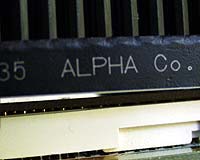
There was even enough off-centre pressure on the CPU that it was levered up out of its socket slightly. Ugh.
Fortunately, this problem was easy to fix. Simply sliding a bit of cut-off cable tie under the too-low end of the cooler perfectly straightened it. On the next boot, the CPU temperature started low and stayed that way.
Jolly good. Time to wind that sucker up!
Overclocking
My first attempts at winding the 500MHz, 100MHz FSB FC-PGA Pentium III up were less than totally exciting, because I was still using my regular ASUS AGP-V6600 NVIDIA GeForce graphics card (reviewed in the comparison here).
With the AGP GeForce installed, any FSB speed from about 120MHz upwards gave an annoyingly unstable system. Everything would work fine, for a while, and then I'd open some perfectly unremarkable application and the system would hang.
It wasn't a heat problem. Despite some very steamy Australian summer weather, the P-III 500E never got warmer than 46 degrees Centigrade, according to the thermal diode built into the processor. The Eagle slotket I'm using the processor with passes the thermal diode signal through to the BF6, whose hardware monitor chip lets software like Motherboard Monitor (or the hardware monitor software that comes on the Abit motherboard CD) keep track of fan speeds and system temperatures. This is a much better way of tracking your processor temperature than the old thermal-probe-on-the-heatsink way.
Since the processor wasn't running hot, and I was using the 1/4 PCI multiplier and therefore running the PCI bus and hard drives slower than normal, it seemed likely that it was the graphics card that was causing the problems. 110MHz FSB seemed stable enough, but winding a 500MHz processor up to 550MHz is not much of an achievement.
So, in the name of outrageous processor speed, the GeForce got the flick in favour of the cheaper but slower PCI Voodoo 3 2000.
Before I evicted the GeForce, I ran a Quake 3 Arena benchmark in 16 bit colour (to fairly compare with the Voodoo 3, which can't do 32 bit rendering). Quake 3 Demo 1 ripped by at 63.9 frames per second, in 1024 by 768, with the processor at 500MHz.
The GeForce came out, the Voodoo 3 went in, the recently-released latest drivers were installed, and I ran the benchmark again. 36.1 frames per second.
Ouch.
And, as it turned out, that was as much as the V3 2000 could pump out; on overclocking the processor, the frame rate barely budged.
Mind you, 36 frames per second for a fairly hectic multiplayer game in 1024 by 768, with lots of pretty-options turned on, is pretty good. You won't be badly handicapped by that kind of performance, even in highly competitive company. The Voodoo 3 bogs down when it has to deal with overlapping transparent effects, but it's not disastrous; for the money, this is a fine card.
And it doesn't hold the processor back, that's for sure.
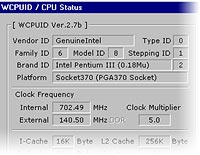
700MHz confirmation, courtesy of WCPUID
FSB speeds above 120MHz were now easy to reach, and 700MHz seems to be perfectly stable. To maintain stability as I wound up the CPU speed, I also pushed the CPU supply voltage up. I was impressed by how little the CPU temperature rose as I incremented the supply voltage and CPU speed; when running at 1.75 volts and 700MHz, the 500E still doesn't crack 50 degrees Centigrade at most, and averages scarcely more than 45 degrees - a long way down from crash-causing temperatures. The Alpha heatsink certainly helps, but I think the P-III would still be happy as a clam even with its stock cooler. If you don't have to put up with the high ambient temperatures of an Australian summer, there's even less likelihood that you'll need extra cooling for a FC-PGA P-III.
Mind you, even computers in very cold rooms can overheat, if their ventilation is poor. The case I installed the BF6 in is... well, it's quite well ventilated, thank you.
The limit for this 500E seems to be somewhere between 700 and 750MHz (150MHz FSB). Possibly it's the PC133 RAM giving up the ghost at 150MHz, but it's only a 13% overclock from 133MHz, so I doubt it. Likewise, all of the PCI bus gear should be able to tolerate the 37.5MHz speed it's being stretched to at 150MHz FSB. 750MHz works, but it's quite flaky.
I lacked the energy to find a speed between 700 and 750MHz that was still stable; even if the system worked fine at 745MHz, I'd still have gained only another 6.4%. If every little bit counts for you, though, the BF6 is the board to use; those 1MHz increments let you find exactly where the bleeding edge is for your particular combination of gear.
Value for money
If you're happy to use a PCI video card, a board like the BF6 will let you turn a $AU500 processor into a $AU1200 one. If you want AGP, though, then the amount of extra speed you can expect drops considerably. But let's say you're using PCI video, and get the full 40% overclock. How does this stand in the bang-per-buck department?
Well, that 700MHz P-III may cost three times as much as a 500MHz one, but it's only 40% faster. And that doesn't mean that a computer built with it will be 40% faster at everything; only when the CPU is the only limiting factor for a task will you see the full benefit. Look at the Voodoo-versus-GeForce Quake 3 results; you could have a billion megahertz processor, and you'd still get less than 40 frames per second in 1024 by 768 from the Voodoo 3.
What are your options? Well, for processors that can plug into Slot 1 motherboards, it's presently P-III or Celeron (with a slotket board). The Celeron is based on the old P-II core and is just as fast as an equivalently clocked P-II for pretty much all tasks. And the P-II is not much slower than the P-III, at the same clock speed; the P-III's chief advantage is that it comes in higher speeds than P-IIs and Celerons.
The fastest Celeron you can get is the 533MHz version. Roughly speaking, it's the equal of a 500MHz Coppermine P-III - maybe 10% slower overall. The faster bus speed of the P-III gives it considerably better memory bandwidth, but for desktop computing tasks this makes no difference to speak of.
Now, if you think you're going to overclock a 533MHz Celeron, think again. It runs from a 66MHz FSB with a monster 8X multiplier, and even 75MHz FSB will see it trying to do 600MHz, which is on the ragged edge for the "Mendocino" core it uses. 600MHz can be done, and has been, mainly by overclockers happy to crank up the processor voltage and use serious cooling.
Generally speaking, 550MHz is the ceiling for easy Celeron overclocking, and only 500MHz is the most plausible target for the slower Celerons.
But never mind the clock speed, feel the price. For a 533MHz Celeron you're looking at $AU380. If you're not planning to overclock - and, let's face it, most people aren't - then why shell out another $AU120 for a P-III 500E?
It gets worse. Let's say you've got an AGP video card, and so can't expect to run the FSB of a BX board at more than 120MHz - quite possibly, not even that. What if, instead, you buy the cheapest Celeron you can find?
C-433s sell for less than $AU200 at present, and slower ones are available from various online dealers - less than $US60 before shipping will buy you a C-333, C-366 or C-400. The various sub-100MHz FSB speeds offered by boards like the BF6 let you get most speeds of Celeron running at around 500MHz.
OK, now you're only out, say, $AU200 for your processor, and you can use slightly cheaper PC100 memory, and your AGP card is happy - 2/3rds multiplier at less than 100MHz FSB - underclocked, but not enough to hurt performance. And you've got 70% of the CPU speed you could expect from a P-III that'd cost you more than twice as much. Maybe three or four times as much, if you find a nice cheap older PPGA Celeron.
If you're counting your cash carefully, it's still Celeron all the way.
Conclusion
It's important to bear in mind that the Coppermine P-III 500E at 700MHz is, as I mention in the slotket review, not only faster than processors with a list price more than twice the $AU500 or so the 500E will set you back, but faster than any Intel processor you can probably currently buy. Stocks of faster P-IIIs are notoriously short, and the highest speed models, announced by Intel to compete with AMD's well-and-truly-available top spec Athlons, just don't presently exist outside of marketing people's fantasies.
Is a 500E at 700MHz the fastest PC CPU you can buy these days? Nope; you can overclock AMD Athlons, too, and they're faster at the same clock speed than P-IIIs. They're not much more expensive, either. But Athlon overclocking requires extra hardware and the courage to crack their case open, while P-III overclocking just requires a board like the BF6. It doesn't even look as if you need an after-market heatsink.
If you're after more CPU speed on the cheap, a 500E, a slotket and a BF6 make an attractive package. The P-III 550E is also available at the moment, though harder to find than the 500E; it sells for about $AU600, and its 5.5 multiplier helps keep FSB speeds a bit more reasonable.
What's next?
Monstrous CPU speed is all very well, but this computer would do better for 3D games with the CPU wound back down to 550MHz or so and the GeForce card reinstalled. If your priority is something more CPU dependent, though, or if you've already got a decent PCI video card that you're happy with, there's nothing wrong with the BX chipset solution.
The obvious next step is to see what good a Via chipset motherboard, with a 1/2 AGP multiplier, can do. An ASUS P3V133 is on my review pile right now!
